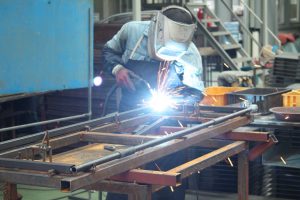
Welding is a metalworking process involving the use of heat to join two or more metal objects. As heat is applied to the metal objects, the surface of the objects begins to melt. When the molten surface cools, it hardens while binding the objects in the process.
But while some welding processes a flame to heat metal, others use electricity. Known as arc welding, it’s characterized by the use of an electric arc — either in direct current (DC) or alternating current (AC) that melts most metals on contact. Below are six surprising facts about arc welding.
#1) It Was Invented in the 1800s
Arc welding has origins dating back to the 1800s, during which a Russian scientist named Vasily Petrov produced a controlled electric arc. Using this same concept, Russian inventor Nikolai Benardos demonstrated how an electric arc is able to join metal objects, thus leading to modern arc welding.
#2) Electric Arcs Typically Reach Around 10,000 Degrees
Electric arcs are very hot, which is why arc welding is such as an effective welding process. While different metals require different temperatures, arc welding is usually performed with an arc temperature of roughly 10,000 degrees Fahrenheit. Of course, this still cooler than plasma torch welding, which can reach up to 50,000 degrees Fahrenheit, but electric arcs are incredibly hot nonetheless.
#3) It Played a Role in World War I
Arc welding played a key role in World War I by streamlining the production of battleships. Prior to arc welding, the Royal Navy used riveted plates to build their battleships. Arc welding proved more effective and efficient, however, allowing Great Britain to build more battleships in less time.
#4) Welding Machines Must ‘Cool Off’
Because of the extreme heat they produce, arc welding machines must cool off to prevent damage or failure. With the exception of commercial-grade arc welding machines, most arc welding machines have a duty cycle specified by the manufacturer, which refers to how many minutes during a 10-minute period the welder should be used.
#5) There Are Different Types of Arc Welding
There are roughly a half-dozen different types of arc welding, each of which uses a different approach. Gas arc welding, for example, involves the use of gas like helium to help fuel the electric arc, whereas plasma arc welding involves the use of plasma.
#6) It’s Inexpensive
When compared to other welding processes, arch welding is inexpensive. Arc welding machines are available for as little as $200, and they require minimal training operate.
There are over a dozen different types of welding, arc, MIG, Robotic MIG, TIG, Laser welding and even friction welding. Monroe is an expert in everyone of them.
No tags for this post.